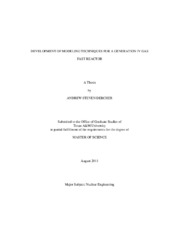| dc.description.abstract | Worldwide, multiple countries are investing a great deal of time and energy towards developing a new class of technologically advanced nuclear reactors. These new reactors have come to be known as the Generation IV (Gen IV) class of nuclear reactors. Similarly to the other designs, the Gas Fast Reactor (GFR) has many advantages, such as electricity production at high efficiency, hydrogen production, minor actinide burning capabilities, etc. However, there are currently no immediate plans to build a GFR due to uncertainties regarding safety issues.
The study conducted herein contains input techniques for the development of new neutronic and thermal hydraulic input decks for the United States (US) Department of Energy (DOE) GFR design. The Monte Carlo N-Particle (MCNP) and MELCOR codes are used to model neutronic and thermal hydraulic characteristics, respectively. These codes are used with the intention of gaining further insight into GFR design and steady state operating characteristics of the US DOE GFR.
Descriptions of inputs for all input decks, along with the results of the execution of both input decks can be found in this thesis. Although many alterations are made to original design specifications, results found in this thesis support the design modifications that have been made. Results suggest that steady-state operation of the GFR is a plausible possibility, given the right conditions. The lack of design criteria for both the reflector and borated shield regions imposes a necessity of invention upon all those who seek to clarify design criteria for the US DOE GFR. Furthermore, resulting temperature profiles for the fuel, cladding and coolant give rise to the possibility of the design of a system, based on thermionic principles, that converts core thermal energy directly to electricity. Such a system is envisioned to provide electricity to a decay heat removal system and possibly increase plant efficiency. | en |


